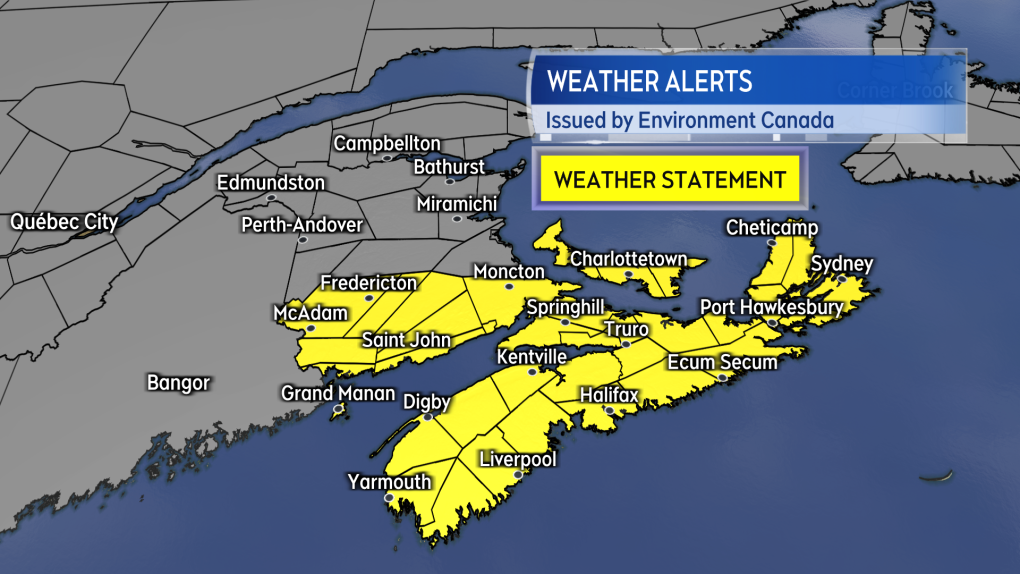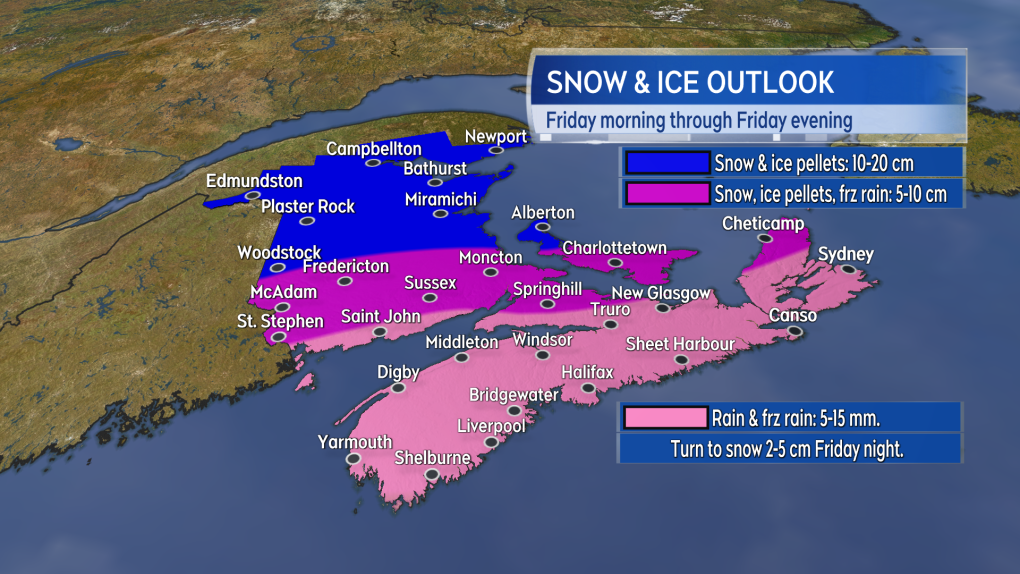Special weather statements issued ahead of freezing rain risk for the Maritimes Friday
The Maritime region is set to experience a weather whiplash when unseasonably warm temperatures drop to below zero at the end of the week.
A south and southwest wind will continue to move milder air up the eastern seaboard into the Maritimes Wednesday night into Thursday.
Temperatures will rise through the night with highs on Thursday expected to range from six to 12 degrees across the Maritimes. In some cases, those temperatures will be warm enough to challenge standing high-temperature records for a Feb. 16.
As an example, the standing high-temperature record for the Halifax area is 10.8 C set in 2016, with the forecast high near 11 C for Thursday. Temperatures for most of the Maritimes will fall back to or below freezing Thursday night, which will contribute to a messy Friday forecast.
 Unseasonably warm temperatures are expected Thursday, potentially breaking some record highs for Feb.16.
Unseasonably warm temperatures are expected Thursday, potentially breaking some record highs for Feb.16.
On Friday, a low-pressure system is expected to come out of the northeastern United States and cross the Maritimes. There is a risk of an extended period of freezing rain and ice pellets for southern New Brunswick, Nova Scotia, and Prince Edward Island. The risk of freezing rain is highest in southern New Brunswick and Prince Edward Island during the day on Friday.
Friday evening and night should see both those areas turn to snow as the temperature falls. For Nova Scotia, the risk of freezing rain/ice pellets may be highest Friday evening and night as temperatures during the day will initially be above freezing.
Environment Canada has special weather statements out for these areas cautioning that freezing rain could extend up to 4 hours in duration.
 Special weather statements are in effect cautioning the risk of freezing rain Friday.
Special weather statements are in effect cautioning the risk of freezing rain Friday.
Central and northern areas of New Brunswick will have colder temperatures so the precipitation there is more likely to be a mix of snow and ice pellets. There is the potential for the snow and ice pellets to accumulate into a range of 10 to 20 cm.
The area of the province that looks most likely to see those amounts runs from Woodstock to Grand Falls and the east toward Miramichi. It is also possible that parts of western Prince Edward Island could end up on the snowier side of the system. Snow totals are likely to range from five to 10 cm for some of the northernmost communities of New Brunswick including Edmundston and Campbellton-Dalhousie.
 A snowy, icy mix of weather is expected for much of the Maritimes Friday. Rain may initially fall during the day in Nova Scotia before turning to freezing rain, ice pellets, and snow Friday evening and night.
A snowy, icy mix of weather is expected for much of the Maritimes Friday. Rain may initially fall during the day in Nova Scotia before turning to freezing rain, ice pellets, and snow Friday evening and night.
A shift north or south with the expected track of the system would have an impact on the amount and type of precipitation expected. For example, if the low does come in further to the north higher snowfall amounts would occur in northern areas of New Brunswick with rain, rather than freezing rain, more likely in southern New Brunswick, Nova Scotia, and Prince Edward Island.
CTVNews.ca Top Stories

Trump picks Brooke Rollins to be agriculture secretary
U.S. President-elect Donald Trump has chosen Brooke Rollins, president of the America First Policy Institute, to be agriculture secretary.
Walking pneumonia is surging in Canada. Is this unusual?
CTVNews.ca spoke with various medical experts to find out the latest situation with the typically mild walking pneumonia in their area and whether parents should be worried.
Lotto Max jackpot climbs to $80M, tying record for largest prize
The Lotto Max jackpot has climbed to $80 million for just the second time in Canadian lottery history.
Retiring? Here's how to switch from saving for your golden years to spending
The last paycheque from a decades-long career arrives next Friday and the nest egg you built during those working years will now turn into a main source of income. It can be a jarring switch from saving for retirement to spending in retirement.
Joly, Blair condemn anti-NATO protest in Montreal that saw fires, smashed windows
Federal cabinet ministers condemned an anti-NATO protest in Montreal that turned violent on Friday, saying 'hatred and antisemitism' were on display, but protesters deny the claim, saying they demonstrated against the 'complicity' of NATO member countries in a war that has killed thousands of Palestinians.
Police thought this gnome looked out of place. Then they tested it for drugs
During a recent narcotics investigation, Dutch police said they found a garden gnome made of approximately two kilograms of MDMA.
'Her shoe got sucked into the escalator': Toronto family warns of potential risk of wearing Crocs
A Toronto family is speaking out after their 10-year-old daughter's Crocs got stuck in an escalator, ripping the entire toe area of the clog off.
Canada's top general takes on U.S. senator in defending womens' role in combat units
Canada's top general firmly rejected the notion of dropping women from combat roles -- a position promoted by president-elect Donald Trump's nominee for defence secretary -- at a security forum underway in Halifax on Saturday.
Ottawa driver fined for hauling thousands of empty cans in trunk of car
Ontario Provincial Police stopped an Ottawa man for dangerously hauling thousands of empty cans from the back of his car.


































